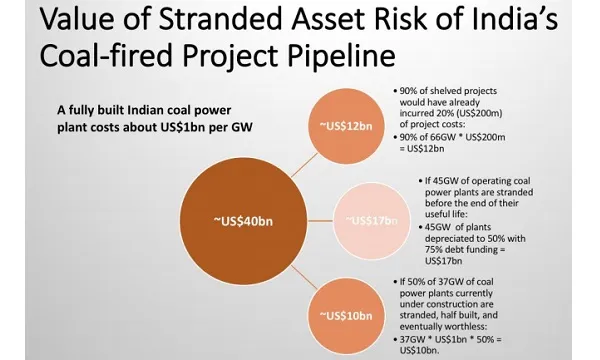
India's coal sector faces stranded asset risks amounting $40b
The resulting liquidity crunch could keep banks from lending to the renewable sector.
Many of India’s coal-fired power projects in the pipeline face stranded asset risks that could amount to $40b, according to the Institute for Energy Economics and Financial Analysis (IEEFA) in a briefing note.
With this, the vast majority of shelved projects are expected to be terminated. Much of those under construction but long delayed are also hit by the underperformance of India’s coal-fired fleet, which has been operating at utilisation rates of 55-60% for the last three years.
Additionally, projects under construction are equally exposed to systematic risk in the sector arising from a lack of coal availability, the lack of new power purchase agreements (PPAs) and payment delays from debt-ridden, state-owned power distribution companies (discoms).
On top of non-performing assets by discoms, the financial stress in India's thermal generation sector amounting to $60b—including $20b from largely stranded gas-fired assets—is causing a liquidity crunch in the country’s energy and financial sectors.
“This is paralysing the banking sector’s capacity to lend to the renewable energy sector, and therefore stymieing India’s renewable energy goals,” said IEEFA analyst Kashish Shah.
Although India is yet to experience global capital flight from thermal coal-fired plants on environmental, social and governance (ESG) grounds, it is seeing capital flight by its domestic financial institutions, as they are increasingly unable to compete with the lower-cost renewable energy infrastructure.
The Reserve Bank of India has been working towards resolving these assets, but its resolution process was found to be favouring promoters over lenders. Banks were taking a 60-80% haircut on their lending whilst developers have protected themselves through financial structures such as special purpose vehicles
Given the financial stress in the sector and competition from renewables, India’s net new coal capacity additions is projected to hit only 30GW by FY2029-2030.
Data from the Global Energy Monitor (GEM) reveals that coal-fired projects in the pre-construction pipeline were halved to 29GW by January 2020, compared to 58GW in January 2019. Of the 28GW absent, 8GW were commissioned and 1GW began construction.
About 46GW of coal-fired power projects have been cancelled in the past twelve months, and 22GW were shelved.








![Cross Domain [Manu + SBR + ABF + ABR + FMCG + HBR + ]](https://cmg-qa.s3.ap-southeast-1.amazonaws.com/s3fs-public/styles/exclusive_featured_article/public/2025-01/earth-3537401_1920_4.jpg.webp?itok=WaRpTJwE)
![Cross Domain [SBR + ABR]](https://cmg-qa.s3.ap-southeast-1.amazonaws.com/s3fs-public/styles/exclusive_featured_article/public/2025-01/pexels-jahoo-867092-2_1.jpg.webp?itok=o7MUL1oO)









 Advertise
Advertise


